Hand Guns of World War II: Military Side Arms of the Major Combatant Powers
[Editor’s Note: Peter Suciu, whose previous articles for armchairgeneral.com have included the small arms (rifles, submachine guns, machine guns) of the major World War II belligerents, turns his attention to the principal hand guns used by Allied and Axis countries. To read Peter’s other related articles please click on the following links: Japanese Small Arms; American Small Arms; British Small Arms; Soviet Small Arms and German Small Arms.]
{default}While military side arms are generally associated with noncommissioned officers (NCOs) and officers, the use of handguns was much more widespread in World War II. Many soldiers carried handguns in addition to their main small arm, and this was especially true of machine gunners, paratroopers, military police — and generally any enlisted man who felt the need for a little extra firepower.
As with the other small arms of World War II, most handguns were distinctive and unique to each respective nation. As a result, the handguns of the era have become quite iconic and in some cases even a bit infamous. From the Colt M1911A1 to the German Luger P08 the guns had unique character of a bygone era.
Here is a look at the most famous and iconic side arms of World War II:
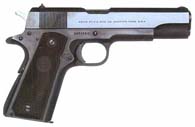 Colt M1911A1 (USA)
Colt M1911A1 (USA)
Often known simply as the “.45,” the M1911 was actually a holdover from World War I. This single-action, semi-automatic handgun was magazine-fed and recoil-operated. As noted by its famous moniker, it fired the .45 ACP (automatic Colt pistol) cartridge.
The pistol was actually designed by legendary gun maker John M. Browning, and was the standard-issue side arm of the United States armed forces from 1911 to 1985, and is actually still used by some U.S. forces today. Some 2.7 million M1911 and the later M1911A1 variation were produced throughout its long service with the U.S. military. World War II production actually exceeded 1.9 million units, with versions produced by several companies including Remington Rand, Colt, Ithaca Gun Company, Union Switch & Signal and even Singer Sewing Machine company. It is worth noting that so many M1911A1s were produced during World War II that the government never actually ordered new pistols, and instead relied on existing parts inventories in the years following the war.
As a side note, the Colt M1911 was also produced in Norway under contract prior to the war, and production continued after the German occupation. Just slightly more than 900 were stamped with the Nazi Waffenamt codes and these are highly sought after by collectors.
M1917 Revolver, formally United States Revolver, Caliber .45, M1917 (USA)
 While it might seem anachronistic to develop a revolver following the development of the Colt M1911 pistol, the United States military had a shortage supplying the latter during World War I and turned to Colt and Smith & Wesson, two of the largest producers of civilian revolvers, to adapt their heavy-frame civilian side arms to the standard .45 ACP pistol cartridge. The result was the M1917 Revolver, which improved upon the 1890’s era .38 caliber Colt and S&W revolvers.
While it might seem anachronistic to develop a revolver following the development of the Colt M1911 pistol, the United States military had a shortage supplying the latter during World War I and turned to Colt and Smith & Wesson, two of the largest producers of civilian revolvers, to adapt their heavy-frame civilian side arms to the standard .45 ACP pistol cartridge. The result was the M1917 Revolver, which improved upon the 1890’s era .38 caliber Colt and S&W revolvers.
While primarily used by secondary and non-deployed troops, the M1917 saw service in both World Wars and even remained in service at the start of the Cold War. It remains an iconic gun of the inter-war era handgun and can be seen as Indiana Jones choice of side arms in the film Raiders of the Lost Ark.
 Luger P08 (Germany)
Luger P08 (Germany)
The infamous “Luger” is perhaps the only side arm more iconic than the American “.45.” Developed by Georg J. Luger in 1898, the gun was actually an evolution of Hugo Borchardt’s C-93. Production of the Luger began in 1900, and the gun was primarily made by German arms maker Deutsche Waffen- un Manitionsfabriken (DWM). It was originally chambered in 7.65x22mm Parabellum, but later modified to the more common 9x19mm Parabellum (now known as the 9mm Luger) cartridge.
The German military however was not the first to adopt the pistol, as the Swiss Army evaluated it, and adopted it as the standard military side arm in 1900, followed by the German Navy in 1904. It was even considered by the American Army briefly before DWM and the American testers parted ways. It was finally adopted by the German Army in 1904 and remained the official side arm until 1938, when it was to be replaced by the Walther P38. However, it was still in widespread use throughout WWII, when it became a prized souvenir to Allied soldiers. It remains one of the most collected military side arms today.
Walther P38 (Germany)
 The Walther P38 first entered tests in 1938, when it was accepted as the replacement for the Luger, but it didn’t enter widespread production until 1939. It was originally meant to fully replace the older P08 by 1942, but wartime production never reached full capacity. The P38 relied on the standard 9x19mm Parabellum bullet, but other versions were produced in 7.65x22mm and even .22 Long Rifle, while experimental .45 ACP and .38 Super versions were also produced in very limited numbers. Originally the handgun was fitted with walnut grips, but as the war continued these were replaced with Bakelite grips.
The Walther P38 first entered tests in 1938, when it was accepted as the replacement for the Luger, but it didn’t enter widespread production until 1939. It was originally meant to fully replace the older P08 by 1942, but wartime production never reached full capacity. The P38 relied on the standard 9x19mm Parabellum bullet, but other versions were produced in 7.65x22mm and even .22 Long Rifle, while experimental .45 ACP and .38 Super versions were also produced in very limited numbers. Originally the handgun was fitted with walnut grips, but as the war continued these were replaced with Bakelite grips.
Perhaps because of the reputation of the Luger the Walther P38 was typically overlooked by American souvenir hunters and even gun collectors for many years. However, the handgun has become more popular with collectors today. It also remains in service with German police units today, proving that the P38 was a reliable and worthy successor to the Luger.
 Walther PP and PPK (Germany)
Walther PP and PPK (Germany)
The name Walther PPK probably sounds familiar, as it is the handgun used by the fictional superspy James Bond. But the gun actually pre-dates the Ian Fleming novels, and certainly the Bond movies. The Walter PP does not mean “Pocket Pistol” as is sometimes noted, but rather “Polizeipistole,” as in Police Pistol, while the PPK was Polizeipistole Kriminalmodell, meaning Police Pistol Detective Model, and issued to plainclothes detectives. It is also worth noting that while the gun was used by Nazi German officials, the PP was first released in 1929 and the PPK in 1931, before the Nazi government came to power.
Both versions are credited with being the world’s first truly successful double action semi-automatic pistols, and hence the action was widely copied – it was used in the later Walther P38. While the handguns were widely used throughout the war – and it was a PPK that was used by Adolf Hitler when the dictator took his own life – both versions remained in use after the war, and have seen numerous improvements. The PPK/E is the latest version produced and it entered production in 2000.
Nagant Model 1895 Revolver (USSR)
 One of the most unique vintage military revolvers is known for its use in Russia, but yet it was in fact a Belgian designed firearm. This was the Model 1895 Nagant revolver, which was in actuality developed in 1894 by Emile and Leon Nagant, two Belgian gun designers, who had previous experience with the Russian arms industry. Their development of the revolver coincided with the Imperial Russian Army’s need for a new sidearm, which the firm of Fabrique d’armes Emile et Leon Nagant designed and brought to production. The Nagant brothers were already well known at the Russian Court as they had previously helped design the Mosin-Nagant Model 1891 rifle.
One of the most unique vintage military revolvers is known for its use in Russia, but yet it was in fact a Belgian designed firearm. This was the Model 1895 Nagant revolver, which was in actuality developed in 1894 by Emile and Leon Nagant, two Belgian gun designers, who had previous experience with the Russian arms industry. Their development of the revolver coincided with the Imperial Russian Army’s need for a new sidearm, which the firm of Fabrique d’armes Emile et Leon Nagant designed and brought to production. The Nagant brothers were already well known at the Russian Court as they had previously helped design the Mosin-Nagant Model 1891 rifle.
One of the Nagant’s unique features is that when the trigger is pulled to fire the pistol, the cylinder moves forward to make contact with the rear opening of the barrel, forming a tighter ‘gas seal’ with the specially-designed cartridges (the cartridge completely encases the bullet, giving it the outward appearance of a ‘blank’ cartridge). This feature is only partially successful, however, and the ‘gas seal’ is not particularly an efficient one since some of the gas produced by the exploding charge still escapes through the ‘not-quite-air-tight’ seal. The few extra feet per second of the bullet gained by this awkward feature does not seem to really be worth the effort.
The Nagant M1895 was produced throughout World War I in both single-action and double-action versions, and this has come to be known as “private’s” or “enlisted” models and “officer’s models” respectively. However, whether this is fully accurate has yet to be absolutely determined. What is a known fact is that except for rare examples for target competition and similar uses, production of the single action variety ended in 1918. Likewise many single-action revolvers were converted to double action, and as a result today single-action examples are extremely rare.
While the Nagant M1895 was in fact designed for the Czar’s army, it did remain in use through the Russian Revolution and Civil War, and was utilized by the Soviets, including by members of the notorious NKVD secret police.
 TT33 (USSR)
TT33 (USSR)
In the 1920s, after the end of the Russian Civil War, the Soviet Union’s Red Army looked to replace the aging and obsolete Nagant M1895 revolver. During the mid to late 1920s a number of pistol designs were considered, and the winner was the TT-33, or Tula Tokarev, designed by Fedor Tokarev. This firearm would become the main service pistol for the Soviet Union, and remain in service through World War II and beyond, being adapted by numerous other Communist Bloc nations under license. Interestingly, the Red Army had relied on numerous foreign handguns, notably the Mauser C96 “Broomhandle.” This weapon’s 7.63mm cartridge had proven reliable was thus popular with the gun’s users. It, along with American handgun designs, would serve as inspiration for the new Soviet firearm.
Fedor Tokarev noted the popularity of the 7.63x25mm ammo used by the C96 when he designed the TT-33, a short recoil operated, locked breech pistol. Tokarev’s design is chambered for a 7.62x25mm Tokarev cartridge, which was itself actually based on the 7.63x25mm Mauser cartridge (they are interchangeable). The handgun design further called up John Browning’s swinging link system, which was “borrowed” from the Colt M1911 pistol. Externally the gun has a passing resemblance to the earlier Browning blowback operated FN Model 1903. Despite these facts it is incorrect to call the TT-33 a 1911 clone, or suggest that Tokarev merely copied Browning’s innovations.
Known as the TT-33, the “Tokarev” pistol actually entered service in early 1934 and was manufactured in great numbers prior to the outbreak of World War II. By the time of the Nazi invasion of the Soviet Union in June, 1941 some 600,000 TT-33s had been produced, and this number increased greatly during the “Great Patriotic War” as World War II is known in Russia. No definitive number of Soviet made TT-33s has even been published, but it is safe to say that millions were likely made. However, production never reached the point that permitted the aging Nagant M1895 pistol to be fully removed from service. The need for firearms during the war was simply too great.
Webley Revolver (Great Britain)
 To say that the British were not exactly ready for World War II is a true understatement, and it shows in the nation’s small arms development. This of course included the side arms, and the British made do with the basic Webley revolver that was first introduced in 1887, and which actually remained in use until 1963!
To say that the British were not exactly ready for World War II is a true understatement, and it shows in the nation’s small arms development. This of course included the side arms, and the British made do with the basic Webley revolver that was first introduced in 1887, and which actually remained in use until 1963!
This top-break revolver features an automatic extraction system that helped with the reloading. The first version of the handgun, the Webley MkI was adopted in 1887, while the Mk IV saw widespread use in the Boer War. The Mk VI version is perhaps the most well-known model, and was introduced in 1915 during World War I. The gun fired the large .455 Webley cartridge, making the service revolvers the most powerful top-break handguns ever produced. Despite being officially replaced by the Enfield No. 2 Mk I revolver, the Webley saw widespread use in World War II.
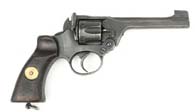 The Enfield No. 2 Mk I Revolver (Great Britain)
The Enfield No. 2 Mk I Revolver (Great Britain)
Due to the large .455 cartridge of the Webley, the British Government looked to replace that side arm following World War I and the result was the Mk I Revolver made by Enfield, which fired the small and lighter .38 caliber bullet. The thought was that it would be more accurate revolver. Approximately 270,000 of these were produced in all, making it a much less common firearm than the Webley. As with the Webley the Enfield handgun remained in use until 1963 and was used in a number of post-war conflicts.
Type 26 (Japan)
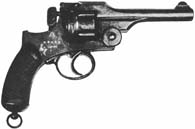 First introduced in 1893, the Japanese produced Type 26 “hammerless” revolver was actually the first modern pistol adopted by the Imperial Japanese Army. It saw service in the 1904-05 Russo-Japanese War, World War I and World War II.
First introduced in 1893, the Japanese produced Type 26 “hammerless” revolver was actually the first modern pistol adopted by the Imperial Japanese Army. It saw service in the 1904-05 Russo-Japanese War, World War I and World War II.
The model number refers to the 26thyear of the reign of the Meiji emperor, which was 1893. The Type 26 was outdated by the outbreak of World War II, but remained in service as an auxiliary weapon due to a shortage of small arms.
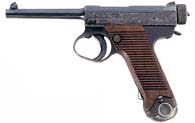 Type A/Type 14 (Japan)
Type A/Type 14 (Japan)
The first Japanese pistol, the Type A, was design by General Kijiro Nambu in 1902. The later version, the Type 14, also designed by Nambu, entered production in 1926 (or the 14thyear of the Yoshihito). Both versions are often simply known as the “Nambu.” While the handguns resemble the German Luger, neither the Type A nor the later Type 14 were based on the P08 design. The Nambu instead employs a recoil spring action to the toggle-locked, short recoil action of the Luger.
It is worth noting that the Nambu was never officially adopted by the Japanese military. Japanese officers were expected to purchase their own pistols, and the Nambu was made available for officers to purchase. The Nambu was mainly produced by the Tokyo Arsenal, while some models were also made by the Tokyo Gas and Electric Company. Some 200,000 models in total – of both the Type A and the Type 14 – were produced by the end of World War II.
The pistol fired the 8mm cartridge, which was considered under-powered compared to the other handguns of the era. Other shortcomings included crude sights and weak magazine springs that resulted in misfires. However, the gun did catch the eye of William B. Ruger, a US Marine, who went on to create the Ruger Standard after duplicating two Baby Nambus in his garage after the war.
Type 94 (Japan)
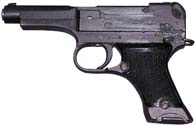 The Type 14 was not the only Japanese pistol designed by Nambu, who also was responsible for the 1934 designed Type 94 (based on the Japanese year 2094, which was believed to be the date from the creation of the world). It was designed to be smaller and simpler to produce than the Type 14, but still used the same 8mm rounds. The gun – ugly, awkward, and not well balanced — is known for a design flaw that allows the gun to be accidentally discharged by pressing the exposed trigger bar on the left-hand side of the receiver. Countering this claim is the opinion that the safety should be left on until the gun is ready to be fired — yet, a pistol that can be fired simply by pressing on one side still seems “non-user friendly” and highly dangerous.
The Type 14 was not the only Japanese pistol designed by Nambu, who also was responsible for the 1934 designed Type 94 (based on the Japanese year 2094, which was believed to be the date from the creation of the world). It was designed to be smaller and simpler to produce than the Type 14, but still used the same 8mm rounds. The gun – ugly, awkward, and not well balanced — is known for a design flaw that allows the gun to be accidentally discharged by pressing the exposed trigger bar on the left-hand side of the receiver. Countering this claim is the opinion that the safety should be left on until the gun is ready to be fired — yet, a pistol that can be fired simply by pressing on one side still seems “non-user friendly” and highly dangerous.
Some 72,000 Type 94 pistols were made by the end of the war, and quality diminished greatly during the later stages of the war, and many of these cruder versions are the ones that were brought home in large numbers by returning American GIs, adding to the mythos of the poor quality of the Japanese Type 94 pistol.
 Vis (Poland)
Vis (Poland)
This handgun has more than a passing resemblance to John Browning’s Colt M1911A1, and in fact was based on that design. There are operational differences, including the fact that the barrel was not cammed by a link as was the case with the 1911. It was also chambered for the European 9mm rather than .45.
The Vis was introduced in 1930 and was the standard Polish side arm at the outset of World War II. Collectors even consider it to be one of the finest handguns ever produced – although seeming rather large and heavy for the smallish 9mm round it fires. After the fall of Poland in late 1939, the Germans continued production of the Vis under the name 9mm Pistole 645. Some 49 were produced by the Poles, while nearly 380,000 were produced by the Germans for use with their police and paratroopers.
Browning Hi-Power (Belgium/USA)
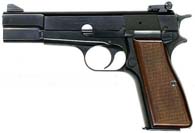 The Vis was not the only handgun produced prior to World War II that was seemingly based on the M1911, as the Browning Hi-Power can attest. The gun was actually based on a design by John Browning, and completed by Dieudonné Saive. The Hi-Power was one of the most widely used military pistols after World War II, but at the outbreak of the war was mainly produced in Belgium and the United States. Unlike the M1911, it was chambered for the 9mm, and featured a high-capacity 13-round magazine.
The Vis was not the only handgun produced prior to World War II that was seemingly based on the M1911, as the Browning Hi-Power can attest. The gun was actually based on a design by John Browning, and completed by Dieudonné Saive. The Hi-Power was one of the most widely used military pistols after World War II, but at the outbreak of the war was mainly produced in Belgium and the United States. Unlike the M1911, it was chambered for the 9mm, and featured a high-capacity 13-round magazine.
Interestingly the Hi-Power pistol was used throughout World War II by both Allied and Axis forces, with the Germans producing models at the Fabrique Nationale (FN) plant in Belgium. Those made by the Germans bear German inspection and acceptance marks, and those guns were used by the Waffen-SS and paratrooper units. Since its introduction in 1935 the gun has been used around the world, and rumor has it that even Iraqi dictator Saddam Hussein was known to carry one.


A bit of clarification on an otherwise great article: The Polish “Vis” was actually the Vis35, the term “Vis actually meaning “Model” in Polish. The Vis35 is also commonly known as the “Radom”, which was actually the name of the arsenel where it was manufactured. It was, and still is, a magnificent, beautifully executed 9mm pistol, and still is a highly desired and collectible weapon from WWII. Thank you for this presentation of pistols and revolvers!
Actually ViS doesn’t mean “model”, you have mistaken it with Wz. which is abbrevation from polish word “Wzór” (which means blueprint in loose translation. So correct name of the pistol is Wz. 35 ViS, where “ViS” is abbrevation from first letters of constructors names.
Also I saw that this pistol is commonly called “Radom”, which is the name of manufactory where they were made.
P.S for the author of the article ^^
I’m grateful that this pistol was included in the article. Just one thing bothers me 🙂
In the article is written that 49 pistols were made before war, not 49 000 (thats pity 90 k ordered ). Its obvious type error, but I was forced to point it out 🙂
Greetings from Poland !
I have an interesting story about a Radom Vis 35 second production by the Nazis. I purchased the pistol from a World War II US army veteran who told me he was stationed in India at a base that supplied American tanks – Jeb Stuart – to the Chinese army. He told me he was part of a supply convoy moving tanks into China that was ambushed by the Japanese. A fire fight continued around the convoy until the next morning when the Japanese were defeated. He had “button-uped” his tank during the night and at day light found a large stack of captured weapons on the back of his tank – one of the weapons was a 9mm Radom with holster and magazine.
I have been told by Radom collectors that Radom pistols were not issued or sold to the Japanese by the Germans. Yet, I found out today that Japanese officers were required to purchase their own pistols and because of faults with the Type 14 some officers purchased European pistols. Can you shed any light on this story?
“vis” in the Radom Polish military gun comes from the Latin meaning strenght.
Referring to the vis pistol The word VIS is latin for Strenght.
In order to make this article perfect, it should be spelled “Deutsche Waffen- und Munitionsfabriken (DWM)”.
The primary reason why the British did nothing to improve their handguns in WW2 (quite apart from the widely-held belief that they were useless for soldiers) was that they were replaced by the Sten – the first mass-produced SMG. It was produced in huge quantities and British and CW divisions in Europe therefore had far more automatic weapons than any other.
In passing that is why the Sten got its evil reputation – being passed to despatch riders, clerks, truck drivers and others with minimal instruction.The reverse is that it was the favourite Allied ‘sidearm’ for German soldiers!
Enfield No 2 Mk 1 revolvers were still in use as late as 1966 in a Britishmilitary police unit I served with in Germany.
I just wanted to reply and say that I have in my possession:
The Enfield No 2, MK 1 Revolver (Great Britain). I fired it at a firing range and it is just like new. My Dad gave it to me in the 1960’s.
This reply is just a matter of information to RT who I guessed served in World War 2.
i have an old german rifle, i cant find any info on it any where, the only thing i know is model 98 8mm mauser, it has three german war eagles with the nazi sign and numbers i cant quite make out i have tried three differant people and no one can seem to tell me anything about it i am hoping you all can help
Sounds like a standard German K98 Mauser to me. I would just look for any import markings usually on the barrel near the muzzle to see if it was imported after the war. The import marks sometimes look like dot matrix printer text.
I’ve seen a standard k98 and my rifle looks nothing like what I have seen and I didn’t see any import markings
Take a look at this video segment. At 1:14 and 1:17 you will see the markings that I think your referring to in your initial comment. Does your firearm differ that much from this one?
Sorry forgot to include the link. http://www.youtube.com/watch?v=OK8nweYnYfY
Yes it does differ a lot, that one is not even close to the one I have ill try and send you pictures
I’m looking for a clip for a 7.65 cal Unique military pistol
I recently purchase a .38 Smith and Wesseon used by bombadier James Newton. The serial number of this weapon is V670976. According to the decendant of Lt. Newton these pistols were modified by shortenibg the barrel because of the cumbersome length caused the bombadier discomfort while sighting the bomb site. Documentation from S&W describes this pistol but states modifications were not done at the factory. The modification is professionaalt done ans is attested to by James Newton as being a usual modification of this weapon for air crews. The weapon has a fitted holster with what appear to be U.S. ordinance markings.
I have a 1931 po8 German Luger serial number 7751 and I cannot find out what caliber it is a 9mm bullet is is 2 big what other size shell will it shoot
I have what was told to me a Belgium pistol from WWII. It has no recognizable name on it. The markings are Automated Pistole Duo Cal 635 FDUSEK OPOtSCHINO. Does anyone know what this is? Thank You!
I have a 25 cal German pistol and holster my Aunt (nurse) took off a wounded SS trooper. The pistol has no proof marks, only 536 on the receiver. I also have the paper work allowing her to bring the pistol to the states.
Thanks
Larry,
What does your pistol look like? Are there any markings on the holster?
Shawn
My Dad was an Air Force pilot in WWII. He had a pen gun, single shot using a 22 long. Are these worth anything or are they illegal? Most people call them a zip gun.
The Swedish/Finnish Lahti and The Italian Glisenti were not as well known I guess.
Hi, I’m writing a book including a history of the Russian women pilots of WWII, and trying to find information on what sidearm they might have carried (586th Fighter Aviation Group, 587th and 588th, which became 46th Taman Guards Night Bomber Regiment and 125th Guards Bomber Aviation Regiment). Photos show them with holsters. Any ideas on what fighter pilots carried? Thank you!
Hello,
I happened onto your site while searching for info about the Nagant 38R revolver. I’m interested in this piece of history and was wondering if you have any information about the metalurgical properties of this revolver? Specifically, was the frame made of better metal in the later models or are they all the same material? Thanks for any info you may have.
Is there a way to identify a gun in a film scene? not sure how to post the picture.
I have a P-38 that a relative took off a downed German officer pilot in WWII..It is looks nickel plated with gold mechanisms (trigger, safety,etc..) It has a small luftwaffe wings engraving or stamp on the slide and serial # is 1107..It is nearly perfect..Any way to find out who was issued this weapon??
i have a walther p-38 that a relative took off of a downed pilot in WWII..it is nickel w/ white grips anf gold mechanisms (trigger, safety, inc it has Luftwaffe wings engraved on stamped on the slide with serial #1107..any way to trace who this weapon was issued to??
I would like to know about a walther patent model 8 pistol with other markings of wattenfebrikmehlis (thur) and 635 on the pistol grips.do not know caliber,got in ww2 in Japanese held islands